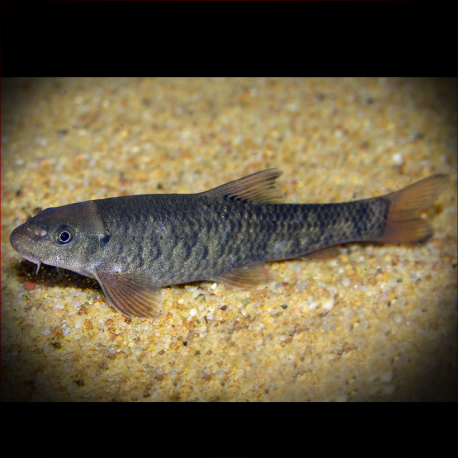More info
Datasheet
| Minimum Tank Size | 240 litres / 63.40 US gallons |
| Maximum Size | 12.0cm / 4.72inches |
| Temperature | 14°C / 57.20°F - 20°C / 68.00°F |
| Hardness | 1.01dgH / 18ppm - 15.02dgH / 268ppm |
| pH | 6.0-8.0 |
General Description
The Garra Rufa, commonly known as Doctor Fish, are species marketed as such with purported skin-cleaning abilities. They represent a complex of closely-related taxa rather than a single species, with variations in appearances across their range. These fish typically display dark or iridescent blue spots on their bodies, with a distinct dark spot at the upper opercle and caudal peduncle. The genus Garra is diverse and constantly evolving taxonomically, ranging across Southern China, Southeast Asia, India, and the Middle East, making a comprehensive generic review challenging. The Garra species are characterized by unique morphological features, such as a modified lower lip forming an adhesive disc and keratinized jaw margins for food scraping.
Aquarium Setup
To maintain Garra Rufa in captivity, a well-maintained tank resembling a flowing stream with a substrate of rocks, sand, gravel, and driftwood is ideal. A planted tank with strong lighting is recommended to develop biofilm, a crucial component of their diet. Clean, well-oxygenated water with a turnover exceeding 10 times per hour is necessary, and additional powerheads and airstones can be used to achieve the required flow. It is essential to avoid adding them to a biologically immature tank and to ensure a secure lid as they have been observed climbing glass.
Behaviour
Garra Rufa are relatively peaceful fish that can coexist with species requiring similar tank conditions. While they don't tolerate conspecifics well in small aquariums, they form loose aggregations in the wild. When kept alone, they may display more aggressive behavior towards similar-looking fish, but purchasing 3-4 or more individuals can help establish a natural pecking order within the group. Tankmates are generally left unbothered by these social interactions.
Feeding and Diet
Although Garra Rufa graze on algae if available, they are not exclusive herbivores. Their diet should consist of meaty foods like chironomid larvae, Tubifex, Artemia, and chopped prawn, along with sinking dried foods rich in vegetable matter. Occasional offerings of fresh fruits and vegetables are beneficial, and homemade gelatine-bound recipes can also be provided. The fish's ability to consume a variety of food types contributes to their adaptability in captivity.
Reproduction & Dimorphism
The reproduction of Garra Rufa involves scatter spawning without parental care, with wild populations spawning continuously between April and November. Sexually mature females are noticeably thicker-bodied than males, while large males develop tuberculated patches on their head and snout. Commercial breeding of these fish is widespread, but the exact populations involved are often unclear, raising questions about the specific species being traded.
Habitat and Distribution
Garra Rufa are found in the eastern Mediterranean and Middle East regions, inhabiting swiftly-flowing sections of headwaters, tributaries, and some lowland river channels. They prefer habitats with clear, oxygen-saturated water that promotes the growth of biofilm. Their distribution spans from Turkey to Iran, encompassing coastal watersheds, river systems, and man-made reservoirs. In the wild, they also inhabit ephemeral habitats that may partially desiccate seasonally.

